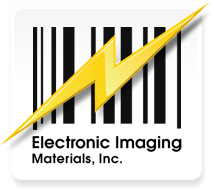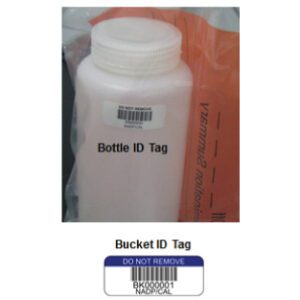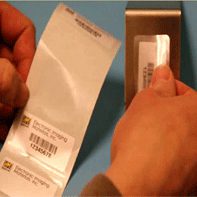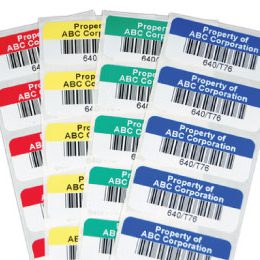At a glance, labeling microscope slides may seem like a simple task. But anyone who’s worked in a clinical or research lab knows better. A mislabeled slide can set off a chain reaction of confusion, retesting, or even diagnostic error. The real culprit is often a poorly selected slide label. These labels are the foundation for sample integrity, compliance, and workflow efficiency.
When exposed to high heat, harsh solvents, freezing temperatures, and constant handling, a generic label doesn’t stand a chance. Here’s what makes slide labeling uniquely complex, and why choosing the right materials can make or break your results.

The Staining Process Isn’t Label Friendly
Slides are stained, treated, exposed to xylene and alcohol, and passed through ovens or high-heat dryers. These steps can wreak havoc on poorly designed labels.
Xylene: The Ultimate Test
Xylene is one of the most aggressive solvents in the lab. It’s used to prepare tissue samples, and it doesn’t care whether your label survives. If your slide label isn’t specifically designed to resist chemical exposure, xylene will blur your print, weaken adhesives, and compromise scannability.
Touch at the Wrong Time? Say Goodbye to the Print
Many labels look fine until a freshly stained slide is removed from the bath. At that moment, the label is vulnerable. One quick swipe of a gloved hand, and the ink is gone. This compromises sample ID, requiring re-labeling or, worse, reprocessing.
Slide Labels Peeling Are More Than a Nuisance
When a label starts to peel, curl, or detach from a microscope slide, it’s not just a cosmetic issue. It’s a threat to the accuracy and efficiency of your entire lab. Slide label peeling is one of the most common but underestimated causes of workflow disruption in diagnostic and research labs. A detached label can jam your automation systems, cause scanner misreads, or mislead technicians during slide retrieval.
Why It Happens
Several environmental and procedural factors contribute to this failure:
- Adhesives that aren’t engineered to withstand xylene, alcohol, or high heat exposure
- Improper surface conditions, such as dusty, oily, or wet glass at the time of application
- Use of incompatible facestock materials that shrink, expand, or lose tack in extreme temperatures or humidity
What It Costs You
Even a single peeling label can halt slide processing, delay test results, and drain valuable staff time. The fallout includes:
- Manual reprocessing of affected slides
- Increased risk of lost or misidentified samples
- Compliance issues if chain-of-custody records are compromised
In high-volume labs, these issues can quickly multiply, costing more in labor, materials, and credibility than most realize.
How to Prevent It
The solution starts with choosing lab labels specifically formulated for slide use. Look for these key attributes:
- Chemical-resistant adhesives that bond securely, even after solvent exposure
- Durable facestocks that block solvent penetration and resist distortion under heat
- Compatibility with thermal transfer printing for sharp, permanent barcodes
Together, these elements can ensure that once a label is applied, it stays intact, legible (if properly handled), and scannable through every stage of your workflow.
Heat, Freezing, and Everything In Between
The microscope slide labeling environment is anything but stable. Your labels are being pushed to survive extremes across the board. Whether your slides face scorching temperatures, repeated chemical exposure, or freezing storage, durability is non-negotiable. Inconsistent materials slow down your process and can jeopardize test results.
Heat-Resistant Labels for Sterilization and Drying
Drying stations, slide ovens, and even autoclaves can expose your slides to sustained temperatures exceeding 70°C. Standard paper labels will shrink, curl, or char. On the other hand, heat-resistant labels are engineered with high-temp polymers and adhesives designed to stay intact through sterilization cycles and high-heat workflows. These labels maintain print clarity and strong adhesion, even after exposure to extreme heat.
Freezer-Safe Lab Labels for Long-Term Storage
On the opposite end of the spectrum, slides are often stored in cryogenic conditions or transported on dry ice. At these temperatures, some label materials become brittle and lose adhesion. Freezer-safe lab labels use flexible adhesives that resist cracking, edge lift, and adhesive failure. For labs labeling specimens post-freezing, EIM’s CryoLabel Frost provides a reliable solution that applies cleanly to already frozen vials, with no need to thaw.
Whether it’s heat, cold, or chemical resistance, selecting the right label material ensures your slides remain readable and secure regardless of the conditions they face.
If your lab has experienced smudged barcodes, curling edges, or time-wasting relabeling, it may be time to reconsider your label strategy. Electronic Imaging Materials (EIM) offers expert guidance and free samples of durable slide labels built to perform under pressure.
It’s Not Just the Slide: Labeling Slide Containers Too
Microscope slides are just one part of a much larger ecosystem. Once labeled and processed, slides are typically stored, transported, or archived in protective containers—slide mailers, filing trays, or cassette racks. These containers need to be clearly and securely labeled as well. If the label on the container fails, your traceability chain does, too.
Real-World Challenges for Container Labels
Slide containers go through a lot:
- Gloved handling that may involve oils, powders, or moisture
- Repeated freezing and thawing for long-term storage and retrieval
- Wipe-downs with alcohol or sterilization processes to prevent contamination
Standard labels often don’t cut it in these conditions. If a container label curls, fades, or falls off, samples can be misfiled, misread, or lost altogether.
What to Look for in Container Labeling Solutions
Effective slide container labels should:
- Use adhesives specifically engineered for plastics and coated surfaces
- Resist edge lift during freeze-thaw cycles
- Maintain legibility and adhesion even after surface cleaning or disinfection
Using the right labels on your slides and the containers they live in strengthens your entire tracking process, minimizing the risk of mix-ups and compliance failures. This full-system approach is key to maintaining sample integrity from preparation through storage.
Automation Demands Label Precision
Automation is no longer a luxury in modern histology and pathology labs. It’s a necessity. Every slide must pass seamlessly through scanning systems, and your labels play a critical role in making that happen.
When your workflow depends on machines for sorting, scanning, or data capture, a misaligned or poorly printed barcode can derail the process. That’s why microscope slide labeling must be engineered with automation in mind.
What Automation Demands From Your Labels
- Precise Barcode Placement: Labels must align within designated zones to ensure machine readability.
- Proper Spacing and Margins: Crowded or off-center barcodes can fail to scan, forcing manual intervention.
- High-Contrast, Durable Print: Scanners work under various lighting conditions. Faded or smudged print won’t make the cut.
The Cost of Getting It Wrong
Even a small skew or inconsistent print can flag your slide for manual handling. This breaks the flow of your automation line, adds labor time, and increases the risk of errors. Automation is only as reliable as the labels feeding into it, so choose ones built for the job.
Why Pre-Printed and Laminated Labels Make Sense
Consider pre-printed slide labels if your lab is short on time or staff. These arrive ready to apply with barcodes, patient info, or batch numbers already in place. Laminated labels offer extra protection against solvents and abrasion, keeping your data intact even when handling gets messy.
Self-laminating options are also available for labs printing in-house. These allow technicians to print, peel, and seal in one motion, reducing the risk of smudges or chemical damage.
Get It Right With EIM
You don’t need to be a materials scientist to solve your labeling problems. You just need a partner who knows the territory. Electronic Imaging Materials builds slide label solutions that account for every step of your workflow. From high-heat resistance to chemical durability, our products are lab-tested to perform.
Here’s what you get with EIM:
- Access to expert labeling consultants
- Free test samples to evaluate in your environment
- Labels engineered for xylene, freezing, and automation
- Pre-printed or self-laminating formats
Let’s eliminate label failure. Contact EIM today to start building a labeling system as precise as your science.





